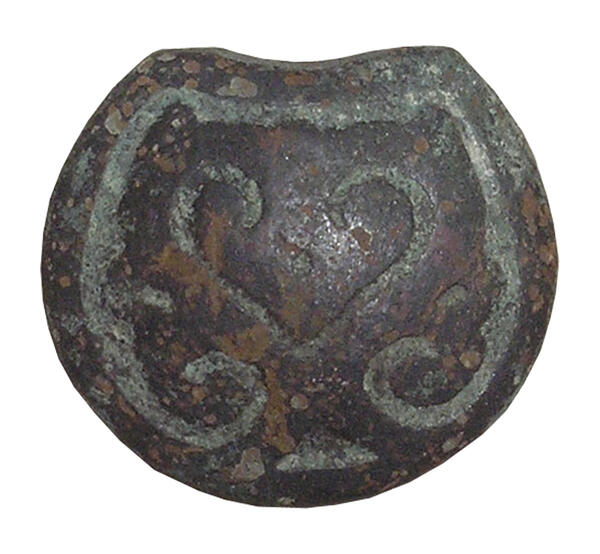The Kursk Regional Museum of Archaeology holds a matrix, one of the main tools of ancient Russian craftsmen. Matrices were used for making various ornaments. They constitute a huge and insufficiently studied cultural and historical stratum, inextricably linked with the history of Ancient Russia.
The matrix was accidentally discovered in the Kursk region. It is made in the form of a spherical segment with a crescent-shaped cut of the top edge. The convex front side is decorated with a deep scroll and triangle pattern, while the reverse side is flat and smooth. Such matrices were used to emboss the pattern on thin metal plates, which served as the basis for making women’s temporal jewelry — kolts, hollow metal pendants, attached to the headdress. Most often embossing was made on thin plates of silver, less often on gold or copper.
A lead plate was usually placed over the sheet on which the matrix pattern was to be stamped, and a wooden hammer was struck on this soft pad, forcing the lead (and the sheet of metal) to fill all the recesses of the matrix. The plasticity of the lead made it possible to accurately reproduce the shape of the matrix on the metal sheet. After the embossing, the workpiece was finished by engraving with the help of a steel chisel. Later, the recesses were filled with niello (an alloy of sulfur, silver and copper) and fired in the furnace for durable bonding of niello and metal. Once cooled, the piece was polished until the niello had a mirror-like shine.
The embossing technique was most productive in making jewelry designed for the mass buyer. Making items with the help of matrices and punches is a very ancient craftsmen’s invention. This production method made it possible to create the same items in fairly large numbers, which satisfied the needs of the community. Along with stamping and engraving, which are even more ancient methods of jewelry making, matrices were the main means of production for many masters — craftsmen of different peoples of antiquity. Jewelers were definitely commissioned by rulers and noble people to create one of a kind pieces, however they used matrices as well. Thus, the invention of matrices was the first step to creating mass-produced art.
The matrix was accidentally discovered in the Kursk region. It is made in the form of a spherical segment with a crescent-shaped cut of the top edge. The convex front side is decorated with a deep scroll and triangle pattern, while the reverse side is flat and smooth. Such matrices were used to emboss the pattern on thin metal plates, which served as the basis for making women’s temporal jewelry — kolts, hollow metal pendants, attached to the headdress. Most often embossing was made on thin plates of silver, less often on gold or copper.
A lead plate was usually placed over the sheet on which the matrix pattern was to be stamped, and a wooden hammer was struck on this soft pad, forcing the lead (and the sheet of metal) to fill all the recesses of the matrix. The plasticity of the lead made it possible to accurately reproduce the shape of the matrix on the metal sheet. After the embossing, the workpiece was finished by engraving with the help of a steel chisel. Later, the recesses were filled with niello (an alloy of sulfur, silver and copper) and fired in the furnace for durable bonding of niello and metal. Once cooled, the piece was polished until the niello had a mirror-like shine.
The embossing technique was most productive in making jewelry designed for the mass buyer. Making items with the help of matrices and punches is a very ancient craftsmen’s invention. This production method made it possible to create the same items in fairly large numbers, which satisfied the needs of the community. Along with stamping and engraving, which are even more ancient methods of jewelry making, matrices were the main means of production for many masters — craftsmen of different peoples of antiquity. Jewelers were definitely commissioned by rulers and noble people to create one of a kind pieces, however they used matrices as well. Thus, the invention of matrices was the first step to creating mass-produced art.






